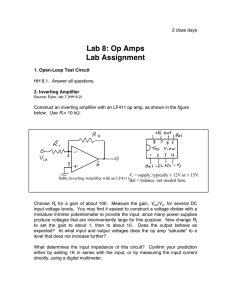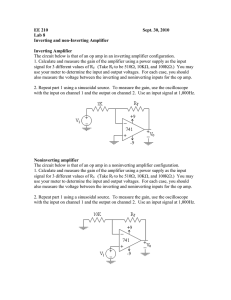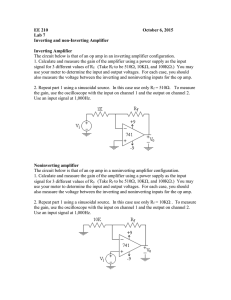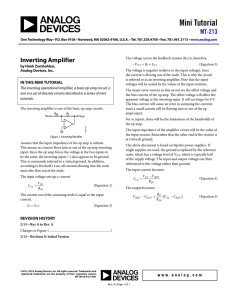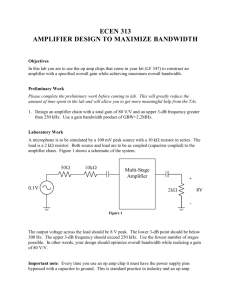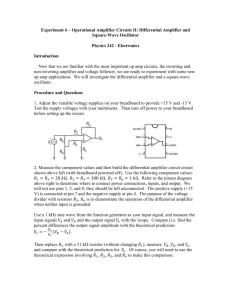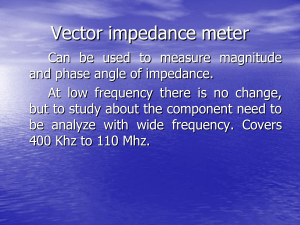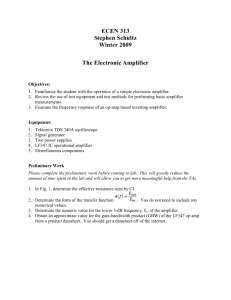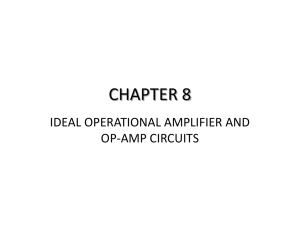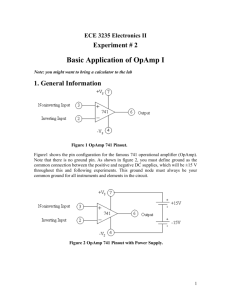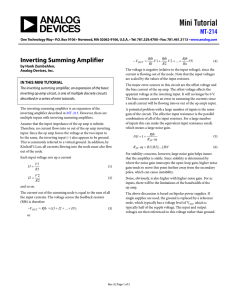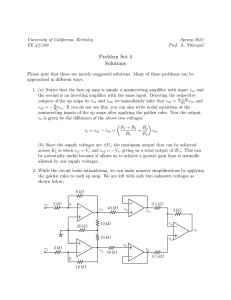Lab 4 - Op Amp Circuits -
advertisement
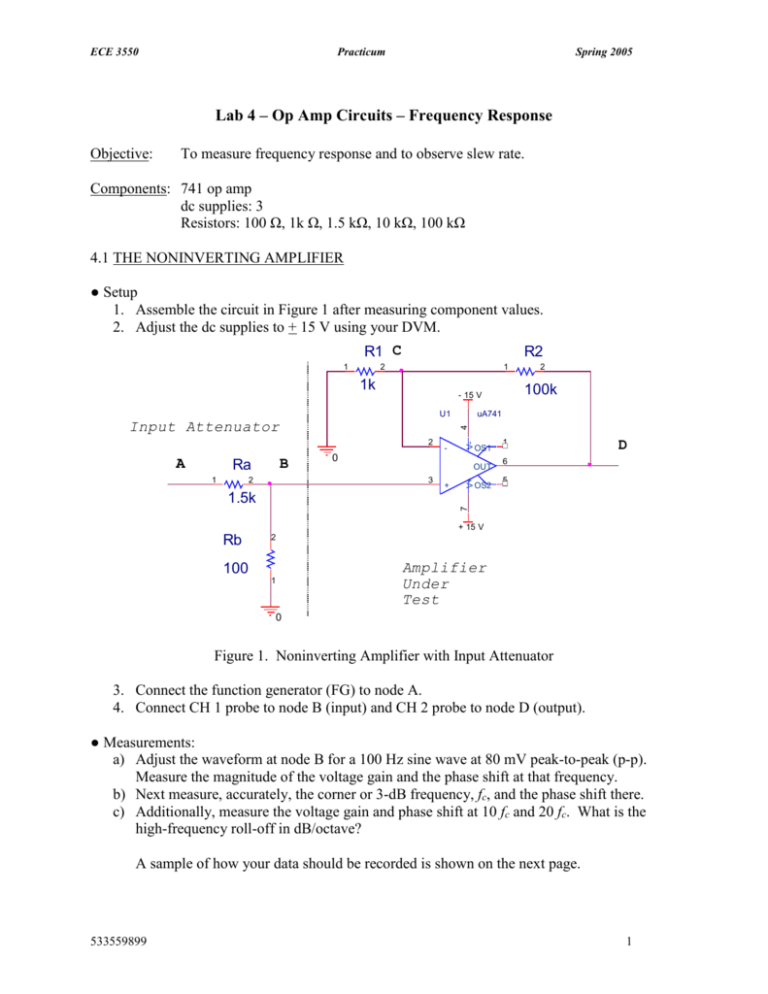
ECE 3550 Practicum Spring 2005 Lab 4 – Op Amp Circuits – Frequency Response Objective: To measure frequency response and to observe slew rate. Components: 741 op amp dc supplies: 3 Resistors: 100 Ω, 1k Ω, 1.5 kΩ, 10 kΩ, 100 kΩ 4.1 THE NONINVERTING AMPLIFIER ● Setup 1. Assemble the circuit in Figure 1 after measuring component values. 2. Adjust the dc supplies to + 15 V using your DVM. R1 C 1 R2 2 1 1k U1 4 2 - OS1 0 OUT 3 + V+ B Ra 1 uA741 V- 2 A 100k - 15 V Input Attenuator 2 OS2 1 D 6 5 7 1.5k + 15 V Rb 2 Amplifier Under Test 100 1 0 Figure 1. Noninverting Amplifier with Input Attenuator 3. Connect the function generator (FG) to node A. 4. Connect CH 1 probe to node B (input) and CH 2 probe to node D (output). ● Measurements: a) Adjust the waveform at node B for a 100 Hz sine wave at 80 mV peak-to-peak (p-p). Measure the magnitude of the voltage gain and the phase shift at that frequency. b) Next measure, accurately, the corner or 3-dB frequency, fc, and the phase shift there. c) Additionally, measure the voltage gain and phase shift at 10 fc and 20 fc. What is the high-frequency roll-off in dB/octave? A sample of how your data should be recorded is shown on the next page. 533559899 1 f, Hz 100 fc 10 fc 20 fc Φ, deg |G|, V/V GdB, dB d) Remove the ground on Rb. Set the FG to a 10 kHz square wave. Increase the FG amplitude to about 8 V p-p. This will cause the output to go deeply into saturation (the limiting should be experienced in both half cycles at about + 12 to + 14 V). Measure the slope of the rising and falling edges in V/μs (volts per microseconds). This is the slew rate (SR) of your op amp. Use the highest possible scope sweep speed for maximum accuracy. Is there much difference in the magnitudes of the slopes? e) Set the input signal to a 100 Hz sine wave and adjust its amplitude so that the output at node D is 10 V p-p. f) Now keeping the output voltage constant at this value, increase the input frequency until the output waveform appears not to be sinusoidal any longer. Note that in this part, the amplitude of the input must be varied in order to keep the output constant at 10 V p-p. g) Record the “ball park” value of the signal frequency where distortion starts. Note that the theoretical value is SR/2πVm, where Vm is 5 V in this case. Displaying vA and vD simultaneously on the same axis should help you detect any significant distortion in the latter. 4.2 THE INVERTING AMPLIFIER ● Setup 1. The circuit is shown in Figure 2. Adjust the dc supplies to + 15 V. A 1 Ra B 2 1 1.5k R1 C 2 2 100k 1k 2 R2 1 U1 - 15 V uA741 100 1 2 Input Attenuator - V- 4 Rb OS1 + OS2 6 D 5 7 3 V+ OUT 1 0 0 + 15 V Amplifier Under Test Figure 2. Inverting Amplifier 2 ● Measurements a) The FG is connected to A. Adjust the waveform at node B (the input) for a 100 Hz sine wave at 80 mV p-p. Measure the magnitude of the voltage gain and the phase shift at that frequency. b) Measure accurately the 3-dB frequency, fc, and the phase shift there; fc should be essentially equal to the corresponding frequency measured in the previous exercise. c) Additionally, measure the voltage gain and phase shift at 10 fc and 20 fc. What is the high-frequency roll-off in dB/octave? 4.3 THE SUMMER ● Setup: 1. Assemble the circuit in Figure 3 with the dc supplies at + 15 V. 2. Create a signal source by connecting a 1.5 kΩ - 100 Ω voltage divider across the FG. Set the output of this circuit to 40 mV p-p at 100 Hz. Connect this source to v1. 3. Using a separate power supply, connect a 50 mV dc voltage to v2. ● Measurements: R2 1 V2 2 1.0k C R1 V1 1 RF 2 1 2 100k 1k U1 - 15 V 2 - V- 4 uA741 OS1 + OS2 6 D 5 7 3 V+ OUT 1 0 + 15 V Figure 3. Summer ● Measurements: a) Record the three signals. Note the phase relation between signals. Note that the average value of vO should be about – 5 volts. If not, could the input offset voltage of your op amp be causing this discrepancy? b) To find out, set both inputs to zero (i.e., replace the sources with short circuits) and measure the dc contribution of the op amp input offset voltage to the output vO. 3 c) Set inputs v1 and v2 back to their original values. Vary the frequency of v1 and accurately measure the 3 dB frequency of the ac portion of vO (use ac coupling on your scope for this measurement). Note that this frequency should be about half the corresponding frequency measured in the previous part. 4.4 THE INTEGRATOR ● Setup: 1. Modify the circuit in Figure 3 as follows: remove resistor R2 and its input signal, and shunt RF with a 0.01 μF capacitor. 2. Using the same voltage divider signal source as before set its output to no more than 80 mV p-p. ● Measurements: a) Verify that this is an inverting integrator by setting the signal source to a 5 kHz square wave and observing and recording the input and output signals. b) The theoretically expected slopes of the output triangle waveform are + Vm/R1C where Vm is the peak value of the square wave input. Are they? What happens to the linearity of the output as the input frequency is decreased? What is the function of RF in this circuit? c) Apply a low frequency (f = 10 Hz) sine wave to the input and measure the gain magnitude and phase shift; these values should be essentially equal to the corresponding low-frequency values measured in the inverting amplifier configuration of Exercise 4.2. Are they? d) Measure accurately the 3-dB frequency, fc, and the phase shift there. d) Additionally, measure the voltage gain and phase shift at 10 fc and 20 fc. What is the high-frequency roll-off in dB/octave? e) Finally, apply a 5 kHz triangle wave to the input and sketch (on the same axes) the input and output waveforms showing key amplitudes and times. f) What is the ratio of the p-p values of vO and v1? Note: The theoretical value of this ratio is 1/(8fR1C). 4.5 REPORT Write a report that includes partner names, date of lab experiment, Title, Objectives, data and observations, and the results/discussion to the following items. 1. Assuming the open-loop gain of your op amp is given by A(jω) ≈ ωt / jω where ωt is its unity-gain bandwidth in rad/s, derive the closed-loop transfer function T(jω) = Vo/Vi for the noninverting amplifier in Fig. 1. Note: Vi is measured at node B. 2. Provide Bode plots for measurements obtained on the noninverting amplifier of Exercise 4.1. Discuss the high-frequency roll-off. 3. Look up the data sheet for the 741 op amp. Compare your measurement of slew rate with the manufacturer’s data. 4 4. Using the magnitude of the voltage gain at 20 fc, for the noninverting amplifier as measured in Exercise 4.1, estimate the value of ft (in Hz) of your op amp. Based on this value of ft determine the theoretically expected value of fc. Compare it with its actual value as measured in Exercise 4.1. 5. Assuming the open-loop gain of your op amp is given by A(jω) ≈ ωt / jω where ωt is its unity-gain bandwidth in rad/s, derive the closed-loop transfer function T(jω) = Vo/Vi for the inverting amplifier in Fig. 2. Note: Vi is measured at node B. 6. Provide Bode plots for measurements obtained on Exercise 4.2. Discuss the high-frequency roll-off. 7. Repeat part (4) for the inverting amplifier of Fig. 2 using the measurements obtained in Exercise 4.2. 8. Assuming an ideal op amp, derive the closed loop transfer function T(jω) = Vo/Vi for the integrator circuit of Exercise 4.4. What is the theoretically expected value of fc.. Compare it with its actual value as measured in Exercise 4.4. 5
